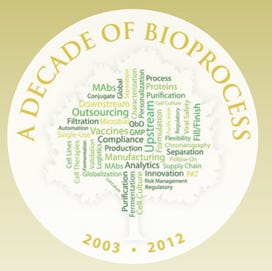From the Publisher and EditorFrom the Publisher and Editor

At about this time of the year, 10 years ago, the four founders of BioProcess International were in arguably the most creative period of their lives. By the middle of 2002, we began designing our collaborative production and operating processes with our new Informa colleagues (then Eaton Publishing). We were assembling author and advertising contacts pretty much from scratch, trading opinions about page designs, building a manuscript pipeline, choosing fonts (something those outside of publishing might not realize can provoke a great amount of discussion!) — all in anticipation of our first issue, planned for January of the coming year. That first-issue’s masthead shows publisher, Brian Caine; associate publisher, Stephanie Shaffer; editor in chief, S. Anne Montgomery; and senior technical editor, Cheryl Scott.
We have since then tried a few things that haven’t worked, but (thankfully) many other things that have. We have held true to our original desire to drive rather than simply report on innovations. In at least two cases (single-use technologies and cell therapies), this approach led us into areas that have taken on lives of their own. But one thing our research for this issue has shown us is that our original editorial plan for BPI has not changed. Our design has been tweaked a bit, here and there, but we are delighted to see that our editorial goals were both sound and adaptable enough to weather the passage of time and maturation of technologies.
As “vertical” a niche as “biopharmaceuticals” might be, the space within it is a highly mixed bag of academic, professional (and corporate/business) disciplines. Engineers, business and project managers, process designers, scientists, researchers, legal counsels, regulatory and quality staff, technicians, and IT staff — all need to find common terminologies and understand their interconnected needs. And as is often pointed out, academic researchers especially have to learn the language and procedures of a regulated industry. Our editorial advisory board is therefore larger (and no doubt a lot more active) than the boards of most similar publications to reflect this broad range of manuscript topics in need of review. As always, we thank them profusely for their continued hard work on our behalf.
This issue — and our 10th anniversary (issue) year — is not about BioProcess International at all. It provides the BPI family with an opportunity to celebrate the scientific and technical accomplishments that enable companies to better treat illnesses, prevent disease, and improve the quality and length of life. We do hope that this issue enhances your appreciation of the wealth of archived and easily accessible literature that we’ve been privileged to publish. Anniversary issues often look at highlights, assembling lists of the top 10 of one thing and top five of another. We wanted instead to illustrate the continual movement of this industry; that is, not to stop and celebrate anything as a done deal, but to simply slow us all to a fast walk for a bit, view the scenery, and reflect on all our multiple (sometime parallel, sometimes intersecting) destinations. This can be a lesson in how “the more things change, the more they remain the same.” But it mostly emphasizes how incremental changes can build impetus for new technologies to reach their tipping points.
To illustrate our understanding of this, this issue’s cover shows a word-tree of the industry BPI covers. A slow-motion video of its (virtual) growth might show steadily and increasingly proliferating branches. Some of those may appear to “dead-end” for a time before a little sprout peeks out and then grows fruitfully into another direction (think about transgenics, for example). We will not stress this metaphor further, but you might consider seed pods, wind, birds….
Tracing those branches can reveal another view: Companies, regulatory agencies, and suppliers continue to advance together and separately in knowledge and skills to build complicated networks of resources. So it is important also to see and appreciate the new shape of things (and predict future growth patterns) by stepping back to take in the whole “forest.”
As you all (we hope!) know by now, our 10-year celebration also includes our new awards program, The 2012 BioProcess International Awards: Honoring a Decade of BioProcess. We want to recognize and honor the technologies, collaborations, and thought leaders that have made the greatest positive impact on upstream, downstream, and manufacturing processes over the past 10 years. The four awards granted within each pillar honor Technology (for suppliers), Technical Application (for end users), Collaboration, and Thought Leader of the Decade. If you, your company, or someone you know is worthy of such distinction, please submit a nomination. You can even nominate yourself! Find a nomination form at www.bioprocessintl.com/awards. And if you have any questions about where yours might best fit into our criteria (there is a place for everything!), please do contact Anne at [email protected]. But hurry: Nominations close 30 June 2012! Three finalists for each award will be announced in July 2012. Winners will be announced during a special, invitation-only dinner and ceremony on 9 October 2012 at the BioProcess International Conference and Exhibition in Providence, RI.
Here, then, is a story of the biopharmaceutical industry’s past decade and current directions, as revealed through our survey of BPI articles and comments from a few of our advisors and authors. We hope that it also conveys our sincere thanks to all of you who have written for us thus far. We wish our readers, writers, and advertisers safe travels through the coming years. And we look forward to continuing to play an important role in your journeys to the future.

Brian Caine
Publisher

S. Anne Montgomery
Editor in Chief
You May Also Like






